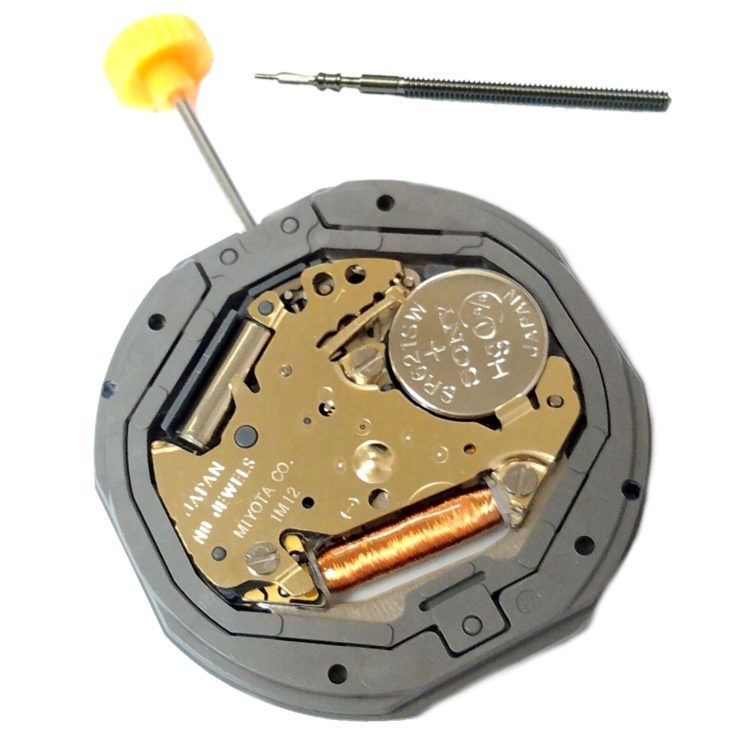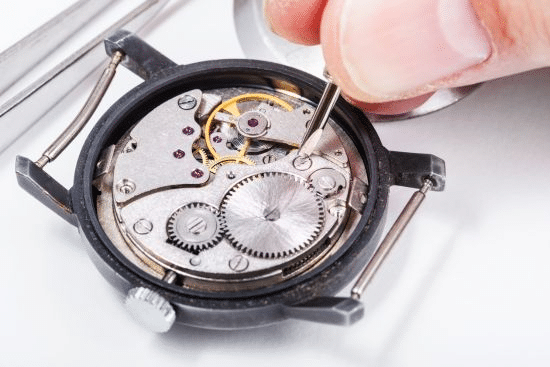10 Common Quartz Watch Problems and How to Fix Them

It’s easy to forget about taking care of your quartz watch. Your precious time piece needs to be serviced if you expect it to last a long time. Some folks often think of quartz watches as lasting forever (8 to 10 years), but without the proper maintenance, it won’t make it that long. There are known Quartz watch problems and ways to resolve them.
We decided to do some research online and compile a list of the most frequently reported issues with Quartz watches. It’s important to know that you can fix some of these on your own, but it’s best to use a repair shop if you are not under warranty and a service center if you are. Any unauthorized work not done by a service center can void your warranty.
In the 60s the quartz watch was invented, which was driven by a battery for power to vibrate a Quartz crystal. When these watches hit the market it created what is known as the Quartz revolution, which took over the timepiece industry by the 1980’s. Since these pocket watches have been around for some time, we are more familiar with the most common quartz watch problems and have better ways of fixing them.
Here are the 10 most common issues reported with quartz watches. There are certainly other issues reported, but these are the 10 our research found to appear the most frequently.
10 Common Quartz Watch Problems and How to Fix Them

The Watch has Completely Stopped
9 times out of 10 this is a battery issue. Most watch batteries can last up to two years, but some quartz watches can extend past three or more years in battery life.
FIX: If your watch has stopped working you can find a watch technician near you that can check the battery for you.
The Second Hand is Jumping in Intervals
This is often an alert for automatic watches to the owner that the battery is almost dead. Watches that do this have a special electronic circuit that determines when the battery is almost drained. The watch will make the secondhand move awkwardly to let you know it’s time for battery replacement.
Fix: If you replace the battery the second hand will return to its normal state.
The Buttons Don’t Work Properly
The push buttons are mounted onto a stem. The stem is encapsulated inside of a tube which resides inside of the watch interior. At the bottom of the tube, there is a tiny spring that pushes the buttons in and out as you press them. Over time dust, dirt, and corrosion can build up inside the tube preventing the button(s) from returning to their starting positions.
Fix: Bring your watch in for service and ask for them to replace the springs in the buttons.
Replacing the Battery Before It Has Reached its End of Life
Some people replace their battery before it has reached its end. The problem with replacing your battery before it reaches its end of life is that you have to break the seal on the back. This is a particular problem with water-resistant watches. Once you open the casing you break the factory seal and need to have a water resistance service performed on it.
Fix: Don’t change your battery until it has actually died. Don’t let new battery of it sit dead in the watch for too long though…it can leak.

The Chronograph Function Shortens Your Battery Life
When you use the chronograph function it is a battery drain and can shorten your total battery life to under 1 year. Watch batteries are built for time and date keeping, extra functions like chronograph require extra power and work from your battery.
A frequent issue is that people forget to stop the special functions like the stopwatch when they are done using them, which keeps the battery working overtime.
Fix: To save power and get better battery life turn off the chronograph function immediately when you are finished using it.
Watch Runs When It’s Not In Use, But Stops When You Wear it
This is a common problem associated with the circuitry inside the watch. When your watch is at room temperature it functions normally because all the circuits are on their contact points.
When you put the watch on your body heat causes a small rise in the internal temperature of the watch and expands the circuitry inside breaking the contact points. Then when you remove it from your wrist it returns to room temperature it starts running again.
Fix: Bring your watch to a service technician for maintenance and ask for the circuit to be replaced.
The Alarm Stopped Working After It Was Serviced
The cause of this issue is normally one of three things; the alarm’s contact spring is not positioned correctly, the case backing is not on correctly, or a problem exists with the alarm contact plate. All three of these are easy fix but will require you to have a service technician look at them.
Fix: Return your watch to the service technician and explain that the alarm stopped working at correct time after maintenance was performed.
The Second Hand Ticks Back in Forth With No Progress and The Watch Has Stopped
This is normally a watch maintenance issue. Essentially the watch is working from an electronics standpoint, but something is wrong mechanically. There are a variety of issues that can cause these symptoms.
Fix: Bring your watch to a service technician for maintenance. This usually can solve this issue.

The Display Has Turned Black and Numbers are No Longer Visible
This is a symptom of extreme shock to a quartz watch. Often the result of being dropped, stepped on, or banged against something. What has happened is the digital display has two thin pieces of glass and it has cracked allowing air to leak in and damage the conductive fluid. This is a very expensive repair.
Fix: The best alternative is often to replace the watch because fixing it costs more than the watch value.
The Display Only Shows Partial Digits and Letters
This is often the result of a shock to the watch like a drop that caused the internal circuitry to be damaged. It’s also possible that the contact points have become corroded.
What is happening is that not all the contact points on the display are receiving the proper power from the battery. Fixing this can cost more than the value of a low to mid-level watch
Fix: For a less expensive watch replacing the watch is the best alternative. For a high-end watch, it may be more worth repairing or sending it to a manufacturer’s service center where the cost should be less than the watch’s total value.
How a Quartz Watch Works?
If you are trying to troubleshoot an issue with a Quartz movement it is helpful to understand how they work. Watch the video below to learn more about how Quartz watches work…
Authorized Watch Repair to Solve Quartz Watch Problems
Whenever you run into any issue with a watch, regardless of the movement type, you need to consider the warranty implications. Most watch manufacturers state in their warranty that any unauthorized repairs will void the warranty. That means if you or any local watch repair shop does any unauthorized work on the watch you “may” void the warranty.
If you have a quartz watch still under the manufacturer’s warranty (usually about 2 years), you should at least consider reaching out to their authorized service center. If the problem is covered then the repairs will be free. Problems t not covered, you will be given an estimate for the repair work. Dealing with an authorized repair center though, most often means mailing in your watch to them and awaiting the result.

Miyota 1m12 MO1035A Quartz Watch Movement Flat Range
Restoration of an Old Quartz Watch
If you have a vintage quartz watch that is having problems, you may want to consider a watch restoration shop instead of a repair shop. A repair shop deals with many types and styles of watches, but restoration is considered an entirely different discipline.
A watch restoration will know where to get replacement parts from the same time period your Quartz timepiece was manufactured. They will also specialize in fabrication. It’s critical when having work done on a vintage timepiece, that you understand how any repairs and changes to the watch impact the overall value.
Solutions and Maintenance Tips for Quartz Watches

Proper Storage
When it comes to maintaining your quartz watch, one of the fundamental steps is ensuring proper storage. A watch case designed for quartz and mechanical watches alike provides a safe environment, keeping them away from extreme temperatures and potential water damage.
It’s worth noting that where you store your watch can significantly impact its internal and external parts, including the quartz movement and crystal. Choose a dry, cool place and consider a watch box that offers compartments to protect each timepiece from physical impacts.
Regular Check-ups and Servicing
Ensuring that quartz watches are working properly involves routine check-ups. Just like a mechanical watch, your quartz watch can benefit significantly from professional servicing.
Watch repair specialists often examine the watch movement. Ensuring all tiny parts are working properly and addressing any movement oxidation that might be present. They’ll also ensure that the watch hands are moving as they should and that the quartz crystal is in good shape.
Battery Replacement and Management
The most common reason why a quartz watch stops working is a dead battery. Attending to the watch battery by ensuring a timely battery change is crucial to prevent issues like battery leakage, which can damage the circuit board and other internal components.
A new battery will not only keep your watch running, but it will also prevent potential damage around the battery compartment. Even if you invest in a luxury watch like a Tag Heuer, neglecting to replace the movement and battery can cause significant issues.
Handling Moisture Issues
Water resistance is a key feature of many watches, but it’s not an absolute guarantee against water damage. If a quartz watch is exposed to moisture, it’s imperative to address it promptly to prevent damage to the movement and quartz crystals.
Ensure the seals on old watch, are in good quality and check them regularly as part of managing moisture issues. Especially when you replace the battery or open the watch case for any reason.
Repairing and Replacing Crystals
The crystal is a crucial part of protecting the dial and internal components of the watch. Quartz crystals in quartz movements are delicate and might need to be replaced or repaired after a certain period or if physical damage occurs. If a crystal is scratched or cracked, the watch might not only look worn but might also be susceptible to dust and moisture. Repairing or replacing a crystal can be a cost-effective way to extend the lifespan of the watch.
Adjusting and Repairing Gears and Hands
Quartz movements typically require less maintenance than mechanical ones, but they’re not entirely free from issues. The gears and hands might need adjusting, especially if they’re not moving as they should or the watch stops working. A professional watch repair technician can carefully disassemble the watch, gently rub or clean the metal components, ensure there’s no movement oxidation. Replace any tiny parts that aren’t functioning as they should.
Maintaining a quartz watch can ensure it serves you accurately for years to come. Whether you’re a fan of Seiko, Tag Heuer, or any other watch brand, understanding the common problems and solutions regarding quartz movements helps in keeping your timepiece in pristine condition.
Comparing Quartz Watches with Mechanical Watches

Quartz watches and mechanical watches have been long debated in the horological circles, each having their distinct nuances and followers. Quartz watches, particularly, have made a significant mark in the industry due to their precision and ease of use. However, there are instances when quartz watches stop working, leading to a spiral of questions regarding their reliability.
In contrasting with an automatic watch, a quartz watch generally employs a stepper motor or step motor, powered by a battery, that propels the watch hands forward, guaranteeing accurate timekeeping. An automatic watch, conversely, utilizes a mechanical mechanism to measure time, driven by a mainspring, a coiled wire of special metal that is wound by turning the crown of the watch.
When delving into the realm of good Swiss quartz movements. You’ll often encounter a higher price tag, which is attributed to the superior craftsmanship and accuracy. A brand new quartz movement, for instance, might warrant a significant investment upfront but tends to promise longevity with proper care. Though possibly requiring attention to intermittent electrical connections over time.
Contrarily, mechanical watches, especially automatic ones, are oftentimes cherished for their meticulous engineering and aesthetic movement, visible through transparent case backs. While a new watch with an entire movement from a revered Swiss manufacturer might lean on the pricier side. Those from emerging brands or those employing more cheap, accessible materials and mechanisms might offer a more affordable ingress into the mechanical watch world.
Quartz Watch Problems – Conclusion
Most items on this list for mechanical watches are fixable. The best way to avoid Quartz watch problems is to be careful with your timepiece and keep up your self maintenance and regular servicing. If you take care of your watch it will last and look fantastic on your wrist every time you sport it.





 Our mission is to help people find local watch repair shops and authorized service centers. As avid collectors we understand how to find trustworthy services that can keep your precious timepiece both functional and beautiful.
Our mission is to help people find local watch repair shops and authorized service centers. As avid collectors we understand how to find trustworthy services that can keep your precious timepiece both functional and beautiful. 